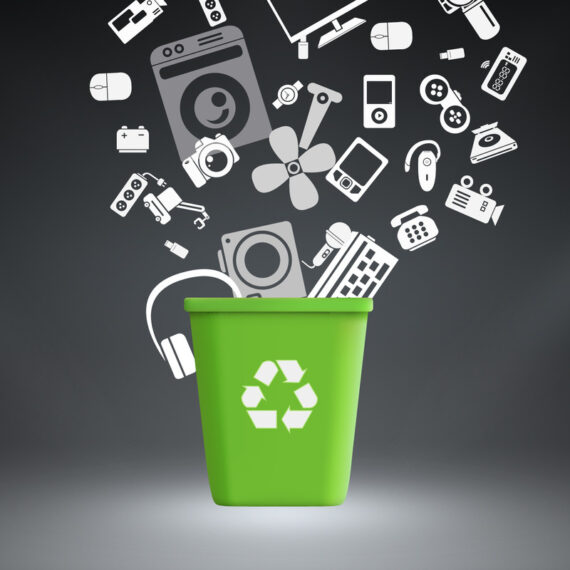
5 Common Mistakes Businesses Make with E-Waste Disposal
In the digital age, businesses are constantly upgrading their technological infrastructure, leading to a surge in electronic waste. Improper electronic waste(e-waste) disposal can have severe environmental and social consequences. Companies should prioritize responsible e-waste management practices that minimize the impact of this growing issue, such as recycling and refurbishing old electronics. By doing so, businesses can decrease their environmental footprint and promote sustainability. In this blog post, we will discuss the five common mistakes businesses frequently make while e-waste disposal and provide practical solutions for each.
Discover Common Mistakes & Solutions That You Make With E-waste Disposal

Mistake 1: Neglecting to Identify and Separate E-Waste
One of the most common mistakes businesses make is failing to identify and separate e-waste from general waste streams. When electronic devices are discarded with regular trash, valuable resources are lost, and hazardous materials may end up in landfills, posing risks to the environment and human health.
Solution: Implement a comprehensive waste management program that includes the proper identification and separation of e-waste. Provide training to employees on how to recognize electronic devices that should be disposed of separately. Designate specific collection bins for e-waste in common areas to facilitate proper disposal. Additionally, consider partnering with e-waste recycling companies offering convenient electronic waste pickup services.
Mistake 2: Lack of Data Security Measures During Disposal
Businesses often underestimate the importance of data security when disposing of electronic devices. Failing to erase sensitive information from old devices can lead to data breaches, compromising confidential business information and potentially exposing customers’ personal data.
Solution: Prioritize data security by implementing thorough data wiping or destruction processes before disposing of electronic devices. Engage with certified e-waste recycling facilities that adhere to stringent data security standards and ensure that all data is securely erased or destroyed. Consider utilizing specialized software or hardware solutions to ensure the complete removal of data from devices before disposal. Additionally, develop clear policies and procedures for handling and disposing of devices containing sensitive information and provide training to employees to ensure compliance.
Mistake 3: Choosing Improper E-Waste Recycling Partners
Selecting the wrong e-waste recycling partner can result in improper disposal practices, negating the intended environmental benefits. Some recycling facilities may export e-waste to developing countries with lax environmental regulations, contributing to pollution and health hazards.
Solution:
1. Research and choose reputable e-waste recycling partners that adhere to international environmental standards and certifications, such as e-Stewards or R2 (Responsible Recycling).
2. Look for facilities that prioritize responsible disposal practices, including proper handling, recycling, and disposal of electronic waste.
Conduct thorough due diligence on potential recycling partners, including site visits and audits, to ensure they meet your organization’s sustainability criteria.
Mistake 4: Ignoring Regulations and Compliance
Failure to comply with local and international e-waste disposal regulations can lead to legal consequences and damage a business’s reputation. Many regions have specific laws governing the disposal and recycling of electronic waste, and non-compliance can result in fines, penalties, and legal liabilities.
Solution: Stay informed about e-waste regulations in your region and ensure your business complies with them. Develop internal policies and procedures that are in line with legal requirements and industry standards for e-waste disposal and recycling. Train employees on relevant regulations and compliance requirements, and regularly update your team on changes in e-waste regulations to maintain compliance. Additionally, establish processes for tracking and documenting e-waste disposal activities to demonstrate compliance with regulatory requirements.
Mistake 5: Overlooking the Circular Economy Approach
Some businesses focus solely on disposing of e-waste rather than adopting a circular economy approach, which emphasizes extending the lifespan of electronic devices through reuse, refurbishment, and recycling.
Solution: Embrace a circular economy mindset by exploring options for device refurbishment and reuse within your organization. Establish partnerships with vendors that offer refurbishment services for electronic devices, allowing you to extend their lifespan and reduce the requirement for new purchases. Encourage employees to return outdated devices for potential reuse within the company before resorting to disposal. Additionally, prioritize recycling and environmentally responsible disposal of electronic waste that cannot be refurbished or reused.
Final Outcome
By avoiding these common mistakes and implementing the suggested solutions, businesses can significantly enhance their e-waste disposal practices. Responsible e-waste management contributes to environmental sustainability, safeguards sensitive data, ensures legal compliance, and supports the transition to a circular economy. Embracing these practices will benefit the planet and improve a business’s reputation as a responsible corporate citizen committed to sustainable practices.
Read Our More Blogs:
How Do You Choose The Right E-Waste Management Partner For Your Business?
Benefits Of Choosing Certified E-Waste Recyclers For Your Business
Follow us:







